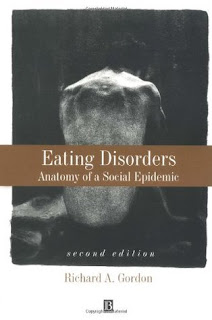Θρησκείες και αποχή από το φαγητό Σεξ και λαγνεία Lifting Το πέπλο Ιστορία των γυναικών Άρης Ένας πλανήτης μεταξύ μύθου και επιστήμης Sherlock Holmes Ερωτας Ναΐτες Ιππότες CRAC Όταν η οικονομία κινδυνεύει να χρεοκοπήσει Ψέμα Απαρτχάιντ Νότια Αφρική Ηθική Σαββατοκύριακο Οι δύο ημέρες που άλλαξαν τον κόσμο Προσευχη Γεωπολιτική Αμβλωση Scoop Όταν η δημοσιογραφία κάνει πρωτοσέλιδα Τεχνητή νοημοσύνη Κράτος και εκκλησία Ευρώπη Περιβαλλοντισμός Διαζύγιο Η λέξη και το σώμα Αποικίες Δικαιώματα Εικόνες Πιστη Σιωνισμός - Οι ρίζες του εβραϊκού κράτους Ωροσκόπος - Γιατι συνεχιζει να μας γοητευει
Οπου υπαρχει ελληνικη βιβλιογραφια την αναφερουμε
Is there a resemblance between the contemporary anorexic teenager counting every calorie in her single-minded pursuit of thinness, and an ascetic medieval saint examining her every desire? Rudolph M. Bell suggests that the answer is yes.
"Everyone interested in anorexia nervosa . . . should skim this book or study it. It will make you realize how dependent upon culture the definition of disease is. I will never look at an anorexic patient in the same way again."—Howard Spiro, M.D., Gastroenterology
"[This] book is a first-class social history and is well-documented both in its historical and scientific portions."—Vern L. Bullough, American Historical Review
"A significant contribution to revisionist history, which re-examines events in light of feminist thought. . . . Bell is particularly skillful in describing behavior within its time and culture, which would be bizarre by today's norms, without reducing it to the pathological."—Mary Lassance Parthun, Toronto Globe and Mail
"Bell is both enlightened and convincing. His book is impressively researched, easy to read, and utterly fascinating."—Sheila MacLeod, New Statesman.
Σχετικα με τον συγγραφεα
Σχετικα με τον συγγραφεα
Holy Feast and Holy Fast: The Religious Significance of Food to Medieval Women (The New Historicism: Studies in Cultural Poetics) (Berkeley: University of California Press, 1988), winner of the Governor's Writer's Day Award of the State of Washington and the Philip Schaff prize of the American Society of Church History.
In the period between 1200 and 1500 in western Europe, a number of religious women gained widespread veneration and even canonization as saints for their extraordinary devotion to the Christian eucharist, supernatural multiplications of food and drink, and miracles of bodily manipulation, including stigmata and inedia (living without eating). The occurrence of such phenomena sheds much light on the nature of medieval society and medieval religion. It also forms a chapter in the history of women.
Previous scholars have occasionally noted the various phenomena in isolation from each other and have sometimes applied modern medical or psychological theories to them. Using materials based on saints' lives and the religious and mystical writings of medieval women and men, Caroline Walker Bynum uncovers the pattern lying behind these aspects of women's religiosity and behind the fascination men and women felt for such miracles and devotional practices. She argues that food lies at the heart of much of women's piety. Women renounced ordinary food through fasting in order to prepare for receiving extraordinary food in the eucharist. They also offered themselves as food in miracles of feeding and bodily manipulation.
Providing both functionalist and phenomenological explanations, Bynum explores the ways in which food practices enabled women to exert control within the family and to define their religious vocations. She also describes what women meant by seeing their own bodies and God's body as food and what men meant when they too associated women with food and flesh. The author's interpretation of women's piety offers a new view of the nature of medieval asceticism and, drawing upon both anthropology and feminist theory, she illuminates the distinctive features of women's use of symbols. Rejecting presentist interpretations of women as exploited or masochistic, she shows the power and creativity of women's writing and women's lives.
Σχετικα με την συγγραφεα
Ginette Raimbault, Caroline Eliacheff - Les Indomptables, figures de l’anorexie
Sissi impératrice d'Autriche, l'Antigone de Sophocle, Simone Weil la philosophe et sainte Catherine de Sienne : quoi de commun entre ces femmes ?
D'avoir refusé obstinément de se nourrir, de s'être tenues indomptables, au bord de la mort. À travers leurs portraits, une interrogation fondamentale sur ce que l'on nomme aujourd'hui l'anorexie.
Ginette Raimbault est psychanalyste et directeur de recherche à l'Inserm. Elle a notamment publié L'Enfant et la mort et Clinique du réel. Caroline Eliacheff, psychanalyste et pédopsychiatre, est l'auteur de À corps et à cris.
D'avoir refusé obstinément de se nourrir, de s'être tenues indomptables, au bord de la mort. À travers leurs portraits, une interrogation fondamentale sur ce que l'on nomme aujourd'hui l'anorexie.
Ginette Raimbault est psychanalyste et directeur de recherche à l'Inserm. Elle a notamment publié L'Enfant et la mort et Clinique du réel. Caroline Eliacheff, psychanalyste et pédopsychiatre, est l'auteur de À corps et à cris.
The Enigma of Anorexia Nervosa, With a New Foreword by Catherine Steiner-Adair, Ed.D.
Hilde Bruch, M.D.
First published more than twenty years ago, with almost 150,000 copies sold, The Golden Cage is still the classic book on anorexia nervosa, for patients, parents, mental health trainees, and senior therapists alike. Writing in direct, jargon-free style, often quoting her patients’ descriptions of their own experience of illness and recovery, Hilde Bruch describes the relentless pursuit of thinness and the search for superiority in self-denial that characterizes anorexia nervosa. She emphasizes the importance of early diagnosis and offers guidance on danger signs. Little-known when this groundbreaking book was first published, eating disorders have become all too familiar. Sympathetic and astute, The Golden Cage now speaks to a new generation.
Σχετικα με την συγγραφεα
by Richard A. Gordon
In an extensively revised new edition of the successful "Anorexia and Bulimia, " Richard Gordon includes new information and discussion of the latest ideas in this rapidly growing research field.
The past two decades have witnessed an enormous increase in the number of cases of eating disorders in industrial societies.
The past two decades have witnessed an enormous increase in the number of cases of eating disorders in industrial societies.
Σχετικα με τον συγγραφεα


























Δεν υπάρχουν σχόλια:
Δημοσίευση σχολίου